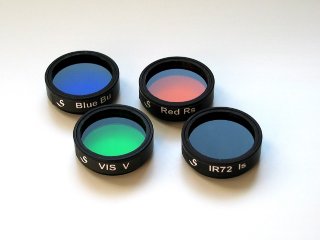|
Although color CCD chips (with Bayer color mask applied
directly on chip pixels) are perfectly suitable for still and video
cameras, astronomers use color chips only exceptionally. Majority of
amateurs, as well as all professionals, use monochrome CCD chips
with color filters. Also cameras on space probes and satellites are
equipped with monochrome chips and multiple filters. This is because
monochrome CCDs are generally more suitable for astronomy (and other
scientific application) for number of reasons:
First of all, monochrome CCD is perfectly capable to take
color image of astronomical objects using color filters. But color
CCD can create monochrome image only at the price of much lower QE
and lower resolution. Color CCD chips have one fixed set of filters without the
possibility to exchange them or to completely remove them. Number of
applications require unfiltered images taken with maximum QE and
color information is not important. Also number of applications
require images in precisely defined spectral range. Monochrome chip
is perfectly capable to take images with narrow-band filters like
Hα, OIII, etc. Professionals prefer
standard photometric (U)BVRI filter set to (L)RGB filters, aimed at
color imaging, for precision photometry etc. Color chips have less QE then monochrome ones. Limiting QE
from to around 25 % (compared to around
80 % QE of monochrome chips) by color
filters only wastes light in number of applications. Color CCD chips do not allow reading of binned images.
Binning would mix the colors from individual pixels and the color
information would be lost. Color CCD chips do not allow so-called Time Delay Integration
(or Drift-Scan Integration). Image drifts over CCD vertical lines in
this kind of integration. But the image drift is synchronized with
image vertical shift. This means image is always exposed on the same
pixels—when the image moves to another row,
accumulated charge in pixels are also shifted into another row.
Image is then read line by line in precisely defined time
intervals.
All reasons mentioned above contributed to the decision to include
filter wheel directly into the G2CCD camera body. The filter wheel has
5 positions for standard 1.25" filters. G2CCD can be sold with
pre-installed filters or the user can install filters according to his
or her needs.
G2CCD camera filter wheel (left) Changing filters inside
the opened camera head (right) Filters for (L)RGB imaging
Moravian Instruments offers the high-quality Astronomik filters
for LRGB imaging. The L-RGB Type 2c filter set is optimized for
CCD chips and individual filters offer near 100 % transmission over its spectral range. The L
(luminance) filter covers the 380 nm
to 670 nm spectral range and blocks
UV and IR part of the spectrum for true color imaging.
But it is also possible to combine the RGB filters with C
(clear) filter to use all available QE offered by CCD chip for
luminance images—handling proper color
balance of astronomical images is more or less a question of
personal preferences either way. The C filter has the same
thickness as color RGB filters so it is not necessary to refocus
the telescope when taking luminance image.
It is also possible to use both L and C filters and fill all
five positions on the filter wheel with CLRGB filters.
Astronomik L-RGB Type 2c filter set in the box (left)
and in the G2CCD filter wheel (right) BVRI filters for scientific applications
Professional photometry applications (note the professional
photometry is often performed by amateur astronomers) require
standard photometric filters. The Johnson-Cousins photometric
system, used within science community, defines five spectral
ranges for U (Ultra-violet), B (Blue), V (Visible), R
(Red), and I (Infra-red) light. The U filter is used
only exceptionally, because the QE of many CCDs is very low in UV
portion of the spectrum and the filter itself has very low
transparency. But the remaining BVRI filters are often used. Any
scientifically valuable photometric measurement, be it variable
star, supernova or asteroid, should be performed using one of
these filters to be comparable to other measurements.
Moravian Instruments offers Schüler—Astrodon professional BVRI filter set, made of
SCHOTT glasses, for the use in the G2CCD camera.

Professional BVRI filter set for G2CCD camera Narrow-band filters
Great gaseous nebulae, like “North America”,
“Pelican” or “California” emit almost monochromatic
light at wavelength 656.3 nm (also known as H-alpha—this light is emitted by hydrogen atoms). Planetary
nebulae often emit light in different wavelengths, e.g. OIII
(495.9 nm and
500.7 nm) or SII
(671.9 nm and
673.0 nm).
Using of narrow-band filters ensures elimination of
almost all unwanted light, caused by light pollution, and passes
the light in which the target object is visible. Moravian
instruments offers number of Astronomik narrow-band filters,
optimized for CCD imaging:
H-alpha (656.3 nm) with 13 nm
bandwidth H-alpha (656.3 nm) with 6 nm
bandwidth OIII (495.9 nm and 500.7 nm) SII (671.9 nm and 673.0 nm)
Warning: H-alpha filters are not intended for observations of
the Sun! They are not constructed to safely block all the Sun
light to be safe for visual or photographic observations of the
Sun. All filters are intended for use at night, for observation of
low-light sources. | 